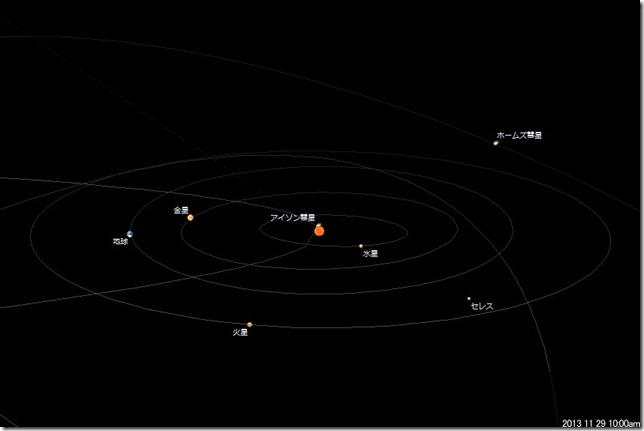« イチョウの黄葉が見ごろに | 最新記事 | 福寿会の夜の横浜駅 »
2013年11月29日
アイソン彗星、蒸発・消滅か?

アイソン彗星は、今朝(日本時間12月29日午前4時ごろ)近日点(太陽に最も近い場所)を通過しました。
星空シミュレーター Stella teatreで軌道を描いてみると、このブログを書いている10時にはすでに太陽をかすめて通過しているはずですが・・・・・・
アイソン彗星は、太陽の中心からの距離(近日点距離)が0.01247天文単位(約190万キロメートル)の距離を通過する彗星で、太陽に極端なほど近い軌道を持っています。
彗星の核(本体)は、「汚れた雪玉」と比喩されるように、岩石や有機物の塵をふくんだ氷です。
太陽に近づくことにより、核が融けて、太陽風や放射圧により尾が形成されます。
太陽に近い場所を通過すると尾が巨大なものとなることが期待されます。
しかし、アイソン彗星は太陽に近づきすぎたようです。
NASAの発表によると、太陽力学観測所など、いくつかの太陽観測所で、近日点を通過する彗星を観測したが、通過直後に予定されている軌道にアイソン彗星が観測されなかったようです。
まだ確定ではありませんが、彗星が崩壊して、蒸発してしまった可能性があります。
NASAによる、太陽に接近し崩壊、蒸発していくアイソン彗星の映像がこちらです。
Comet ISON went around the sun on Nov. 28, 2013. Several solar observatories watched the comet throughout this closest approach to the sun, known as perihelion. While the fate of the comet is not yet established, it is likely that it did not survive the trip. The comet grew faint while within both the view of NASA's Solar Terrestrial Relations Observatory, and the joint European Space Agency and NASA's Solar and Heliospheric Observatory. The comet was not visible at all in NASA's Solar Dynamics Observatory. A white plus sign shows where the Comet should have appeared to SDO. This image from NASA's Solar Dynamics Observatory shows the sun, but no Comet ISON was seen. A white plus sign shows where the Comet should have appeared. It is likely that the comet did not survive the trip. Image Credit: NASA/SDO
アイソン彗星は太陽通過後も巨大な尾を見せてくれるはずでした。
しかし、近日点通過後、次第に消滅していく姿が捉えられています。
アイソン彗星はイカロスの翼になってしまったのでしょうか。
12月初旬に観られるはずであったアイソン彗星の雄大な姿は、残念ながら望めないかもしれません。


